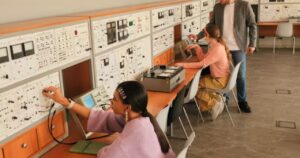Classroom 15x: A Deep Dive into the Future of Learning Spaces
The traditional classroom—rows of desks facing a chalkboard—has remained largely unchanged for over a century. But as educational research reveals new insights about how students learn best, the Classroom 15x model is emerging as a revolutionary approach to designing learning spaces that actually work for modern learners.
Classroom 15x represents a fundamental shift from passive learning environments to dynamic, flexible spaces that adapt to different teaching methods and learning styles. This innovative framework multiplies the potential of traditional classrooms by incorporating technology, flexible furniture, and collaborative zones that can transform based on the lesson at hand.
What Makes Classroom 15x Different?
Unlike conventional classrooms designed around a single teaching style, Classroom 15x spaces feature modular components that can be reconfigured in minutes. Students might start the day in small discussion circles, transition to individual workstations for focused tasks, and finish with collaborative project work in comfortable lounge areas.
The "15x" designation reflects the multiplied learning opportunities these spaces provide. Instead of one static arrangement, educators can create 15 or more different configurations to match their pedagogical goals. This flexibility transforms how teachers approach lesson planning and how students engage with content.
Technology integration plays a crucial role, but not as the centerpiece. Rather than overwhelming students with screens, Classroom 15x environments incorporate digital tools seamlessly into the learning experience. Interactive displays replace traditional whiteboards, while student devices connect wirelessly to share work and collaborate in real-time.
Key Components of Future Learning Spaces
Flexible Furniture Systems
Mobile desks, stackable chairs, and modular seating options allow rapid room reconfiguration. Students can work individually, in pairs, or in larger groups without the constraints of fixed seating arrangements.
Multiple Learning Zones
Each classroom includes distinct areas for different activities: quiet reflection spaces, collaborative work areas, presentation zones, and hands-on activity stations. This variety accommodates different learning preferences and project requirements.
Enhanced Acoustics and Lighting
Sound management systems reduce noise distractions while allowing productive conversation. Adjustable LED lighting mimics natural daylight patterns, supporting student circadian rhythms and maintaining focus throughout the day.
Integrated Storage Solutions
Built-in storage keeps learning materials organized and accessible while maintaining clean sight lines and open floor space for activities.
The Impact on Student Learning
Early implementations of Classroom 15x principles show promising results. Students report higher engagement levels when they can move between different learning zones based on their needs. Teachers observe improved collaboration skills as students naturally form groups and work together more effectively.
The physical environment directly influences cognitive performance. When students have choices about where and how they learn, they develop greater ownership of their educational experience. This autonomy translates into improved motivation and academic outcomes.
Research from educational design experts indicates that flexible learning spaces can increase student engagement by up to 20% compared to traditional classroom settings. The variety in physical positioning also supports different learning modalities, helping kinesthetic learners who need movement and visual learners who benefit from varied perspectives.
Implementing Change in Your School
Schools don't need complete renovations to begin incorporating Classroom 15x principles. Start with simple changes like introducing mobile furniture, creating defined zones with area rugs, or establishing quiet corners with comfortable seating.
Professional development for teachers is equally important. Educators need training on how to effectively use flexible spaces and modify their teaching approaches to take advantage of the increased options. The most successful implementations combine physical changes with pedagogical training.
Budget-conscious schools can phase in improvements gradually. Begin with one pilot classroom to test concepts and gather feedback from teachers and students. Document what works well and what challenges arise, then use these insights to refine the approach before expanding to additional spaces.
Conclusion
Classroom 15x represents more than just rearranged furniture—it embodies a philosophy that learning happens best when students have choices, when collaboration is encouraged, and when the physical space supports rather than constrains educational goals.
As schools face pressure to prepare students for an uncertain future, creating adaptable learning environments becomes essential. The jobs of tomorrow will require creativity, collaboration, and critical thinking—skills that flourish in flexible, student-centered spaces.

